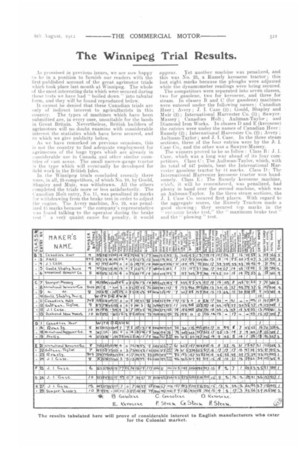The Winnipeg Trial Results.
Page 17

If you've noticed an error in this article please click here to report it so we can fix it.
As promised in previous issues, we are now happy to he in a position to furnish our readers with the first-published account of the great agrirnotortrialt which took place last month at Winnipeg. The whole of the most interesting data which were secured during these tests we have had "boiled down" into tabular form, and they will be found reproduced below. t cannot, be denied that these Canadian trials are only of indirect interest to agriculturists in this country. The types of machines which have been submitted are, in every case, unsuitable for the lands in Great Britain. Nevertheless, British builders of agrimotors will no doubt examine with considerable interest the statistics which have been secured, and to which we give publicity below. As we have remarked on previous occasions, this is not the country to find adequate employment for agrimotors of the huge types which are already in (.ousiderable use in Canada and other similar courtI Has or vast areas. The small narrow-gauge tractor the type which will eventually be developed for field work in the British isles. In Hie Winnipeg trials concluded recently there were, in all, 25 competitors, of which No. 10, by Gould, Shapley and Muir, was withdrawn. All the others completed the trials more or less satisfactorily. The Canadian Holt entry, No. II, was penalized '29 marks far withdrawing from the brake test in order to adjust the engine. The Avery machine, No. 19, was penalized 15 marks because. " the company's representative was found talking to the operator during the brake est " very quaint cause for penalty, it would appear. Yet another machine was penalized, and this was No. 23, a Rumely kerosene tractor; this lost eight marks because the ploughs were adjusted while the dynamometer readings were being secured. The competitors were separated into seven classes, two for gasolene, two for kerosene, and three for steam. In classes B and C (for gasolene) machines were entered under the following names: Canadian Iteer ; Avery; J. I. Case (2) ; Gould, Shapley and Muir (2); International Harvester Co. (3); sawyerMassey j Canadian Holt; Aultrnan-Taylor ; and Diamond Iron Works. In classes D and E (kerosene) the entries were under the names of Canadian Heer ; Rumely (2); International Harvester Co. (2); Avery ; Aultman-Taylor ; and J. I. Case. In the three steam sections, three of the four entries were by the .11,1. Case Co., and the other was a Sawyer-Massey. The winners proved to be as follow: Class B: J. I. Case, which was a long way ahead of its four competitors. Class C: The Aultrnan-Taylor, which, with its total of 447 points, beat the International Harvester gasolene tractor by 41. marks. Class D : The International Harvester kerosene tractor won handsomely. Class E: The Rumely kerosene machine, which, it will be remembered, was penalized, had plenty in hand over the second machine, which was an Aultman-Taylor. In the three steam sections, the J. I. Case Co. secured first places. With regard to the aggregate scores, the Rumely Tractors made a good showing ; they secured top marks in the " ecenomy brake test," the " maximum brake test " and the " plowing " test.






















